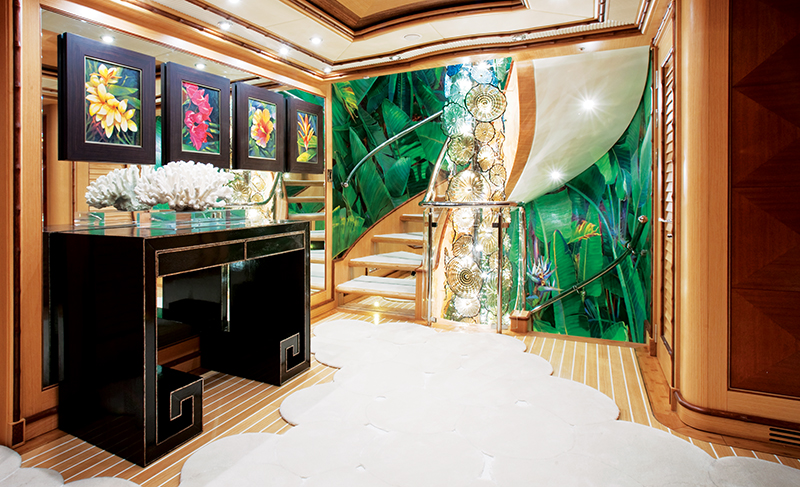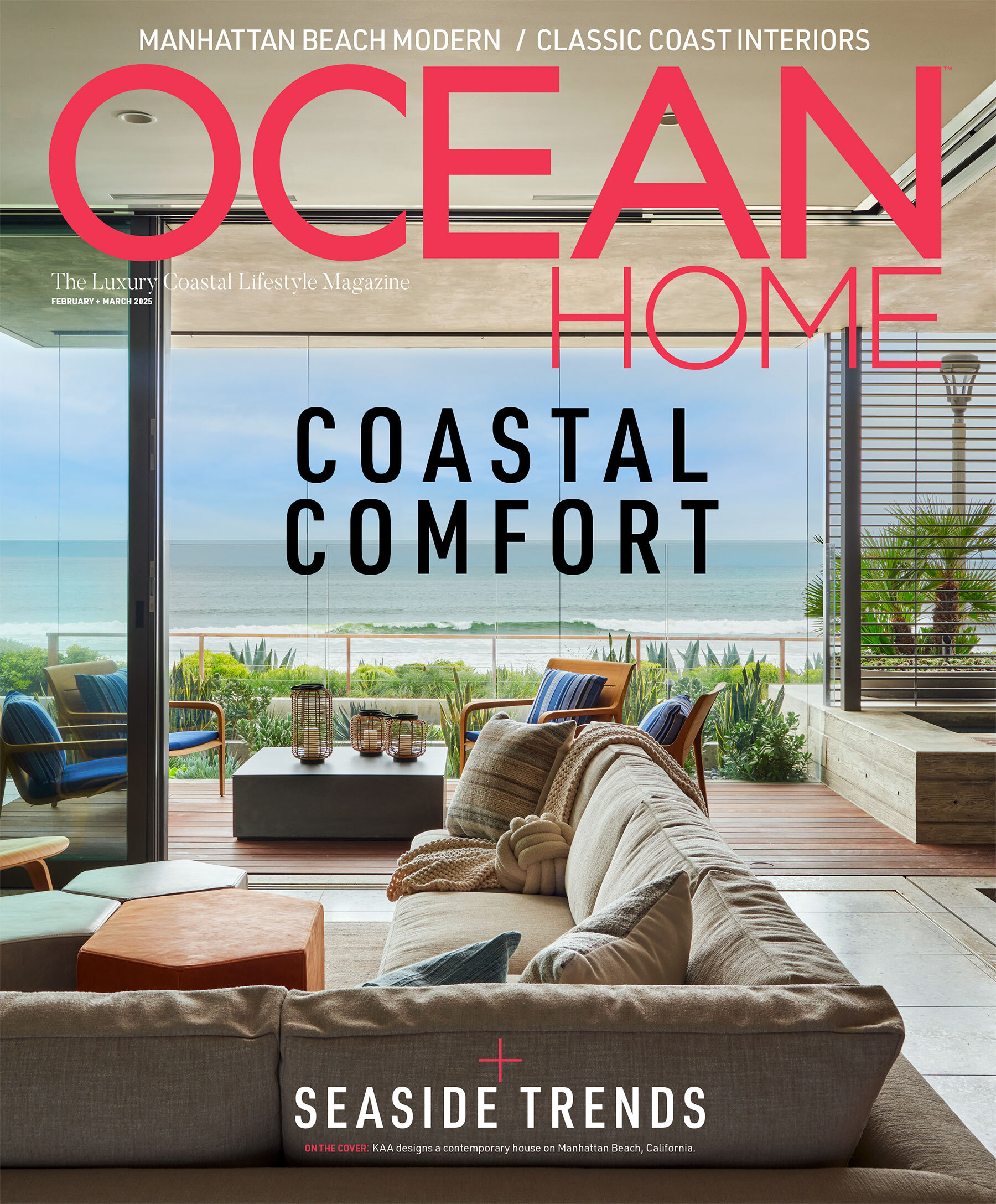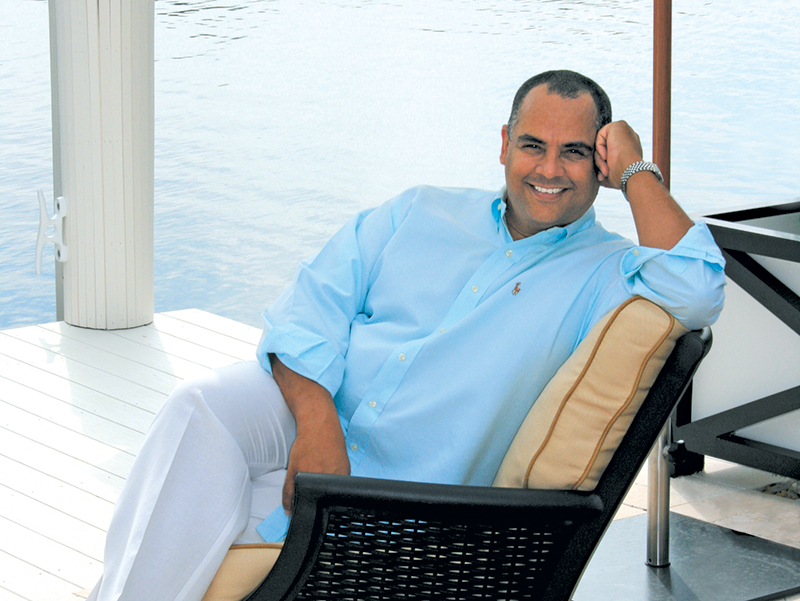When shopping for a private aircraft or a sleek new yacht-and increasingly for a new residence in New York, London, or Nassau- there is one essential telephone number the discerning buyer needs once the paperwork is signed.
Patrick Knowles, the eponymous founder and president of Patrick Knowles Designs – an award-winning interior design firm based in Fort Lauderdale, Fla. – delivers bespoke, one-of-a-kind interiors for private superyachts, planes and residences to a discriminating global clientele.
Knowles has forged an enviable career amid the very symbols of success. But his work is also his passion, and while his residential designs are increasingly sought after by land-based clients, luxury yacht design – with which he is synonymous – remains his great love.
Knowles, 49, was born in the Bahamas, an island nation defined by its spectacular marine environment. The ninth of 10 siblings, he contends it was his father, Eldridge, who fostered in him a love of water. “Exposure to the sea through my father, an avid boater, instilled in me a strong attraction to water,” he says. “Being a yacht designer is a very natural expression for me.”
Based in Florida since 1983, when he arrived in the United States to attend college, Knowles founded his design firm 10 years later. With some 140 design projects already completed, he is in greater demand than ever. He and his dedicated team are currently designing a 165-foot yacht, M/Y Mysorah, due for delivery in 2014; an 86-foot Sportfish yacht; and a private aircraft in Montreal – as well as maintaining a support system to service the yachts that have already been designed and delivered. This “concierge” service, he says, is an important part of the business.
He is also working on residential projects for yacht clients in New York, London, Key Largo and the Bahamas. Part of a growing trend, the projects are hardly a sideline: the London property is seven stories, a traditional residence in affluent Mayfair that the new owner wishes to contemporize throughout. For the New York residential interior, Knowles is also designing much of the silverware, crockery, crystal and linens, a venture that will prepare him for his next move into high-end product design.
“My yacht clients began to commission us for their private residences and corporate offices. For the first time in my career, we are engaged in more land-based projects than marine or aviation,” Knowles says. “We are also currently in discussion for the design of several new yachts which would rectify that equation. I am very grateful that some 80 per cent of our work is repeat business and referrals.”
Knowles’ passion for design and his scrupulous eye for detail are his signatures. But he has made it his business to avoid a signature look. He describes his design philosophy as client-led and totally client focused.
“When prospective clients interview our firm, it becomes evident that our philosophy is theirs. I love design and all aspects of it regardless of genre, color and style, but the project is not intended for me to enjoy so my personal preferences must take a back seat,” he says. “I strive not to have ‘a look’ even for me. I like to project an idea specifically for my clients, which explains the diversity in my portfolio.”
Knowles says he gets the same buzz from a new project that he got from his first – a yacht called Dare to Dream in 1993. The foundation of his success is to listen closely to his clients as they talk him through their vision. The critical phase of the project is the upfront development, which is where he builds the “DNA” of the design. Clients, he says, are routinely surprised to find that even the smallest details have been noted and executed.
  |
The timeline for delivering his unique designs is between two and three years for a yacht, and 18 months to two years for an aircraft. They present some unique design challenges. “Both require a discipline that is not typically found in land-based projects. There is a great deal of structural interface with mechanical systems which exist in a prescribed envelope – the fuselage or hull – and the ability to stray outside of that envelope is virtually impossible, which means everything that is designed must fit. It sounds elementary, but you would be surprised,” he says.
He notes, too, the respect the designer must have for attachment. “When designing an object that is intended to be fixed to a bulkhead or an overhead on a yacht or aircraft, one needs to consider the movement of the environment and how such an object will respond to that movement.”
That principle is applied to everything from cabinetry and railings to furnishings. “When you design something that is inserted into an environment that is mobile, all the rules of the game change.”
Knowles is elegantly modest when pressed for some of the more unusual requests from clients. He admits only to a saltwater aquarium so large that it required a crew member to dive in to maintain it, and a three-story light fixture that spanned all decks of the boat.
The largest aircraft he has designed for is a Boeing 757, but the project he is proudest of is a vintage McDonald Douglas DC6-B that he worked on in 2001, an enormous, four piston-engine aircraft that the Austrian owner had wanted modeled on the Orient-Express. The design and restoration project spanned almost four years. “It was a thrilling experience, I’ll never forget it,” he says.
Knowles admits that demand for his work has gathered pace as the economy has rebounded, and he is quick to credit his team for his firm’s solid order book. “I have always relied heavily on the experience and expertise of my key team members. It truly has afforded us a unique competitive advantage that is not common in a firm as creative and specialized as ours.” patrickknowlesdesigns.com
Image Credits: Kristina Strobel, Sheila Knowles.


